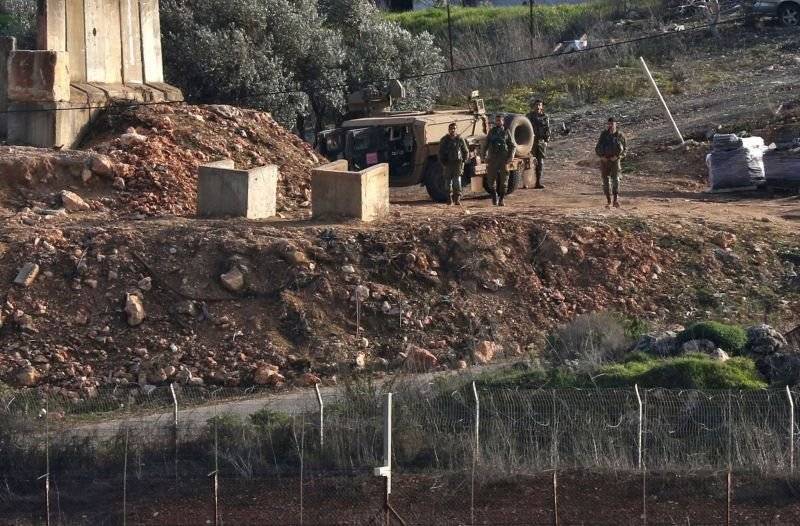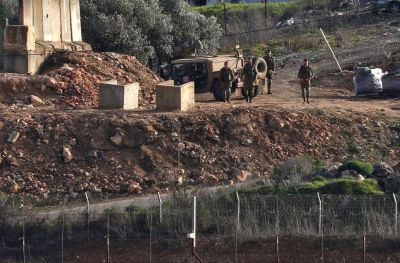
Israeli soldiers gathered near the Lebanese border on Feb. 18. Photo taken from the Lebanese village of Khiam, in southern Lebanon. (Credit: Mahmoud Zayyat/AFP)
While the climate in the region is currently tending towards calm in a context of talks and attempts to resolve thorny issues, Hezbollah has opted in recent days for an escalation, albeit contained, against Israel.
The announcement last Wednesday by the leader of Hezbollah concerning the capacity of his party to produce drones and to adapt and convert its missiles into precision warheads set the tone. Tensions then rose quickly on the border between the two countries after Hezbollah sent two drones, one on Thursday and one on Friday, into Israeli territory. The first was shot down by the Israeli army. The second returned to its base after having “flown over northern Israel for 40 minutes as part of a reconnaissance mission to a depth of 70 kilometers,” according to a Hezbollah statement.
This escalation is all the more unexpected as the Vienna talks, aimed at reviving the West’s 2015 nuclear deal with Iran, seem to be progressing at a rapid pace, auguring an agreement very soon, according to some Iranian sources, and as Lebanon is also approaching an agreement with Israel on the delimitation of its maritime border.
So what is it that has bitten Hassan Nasrallah? Does Hezbollah really have an interest in raising the stakes at such a crucial time for its Iranian sponsor and for Lebanon, whose economic survival depends in part on the future gas and oil resources it covets in its territorial waters? For Hezbollah, these military developments are part of the traditional logic of deterrence and maintaining the balance of terror. With this new show of force, the Shiite party wants to make Israel understand that the balance of control over airspace has been restored.
In his speech on Wednesday, Nasrallah said that Hezbollah has long since begun to produce drones “locally,” stressing that his formation does not need to import them from its Iranian ally.
He also said that Hezbollah is now capable of converting its missiles into precision warheads, and that it has been doing this “for years now.”
The announcement of the adaptation of missiles was not unprecedented. Nor was that of the manufacture of drones, which the party has boasted of in the past. The novelty was in the moment chosen to officially signal to the adversary this qualitative leap, immediately followed by a demonstration on the ground.
According to Israeli security sources quoted by the daily Haaretz, the missiles available to Hezbollah have effectively restored this balance and “made the task even more difficult for the Hebrew State” against the Shiite militia. “In the end, this operation had no military impact on the adversary. It is a symbolic action, nothing more and nothing less,” said Riad Kahwagi, a Lebanese expert on military affairs.
‘The equations have changed’
On Sunday, Nabil Kaouk, a member of Hezbollah’s central council, boasted of the operation, arguing that “the equation has changed.”
“Israeli drones used to violate Lebanese airspace. Today, it is the Lebanese drones that violate the space of the Hebrew state,” he said.
Meanwhile, Faisal Abdel Sater, a military expert close to Hezbollah, said, “This is one of the objectives that Hezbollah has managed to achieve by turning the threat into an opportunity.”
According to several experts from the same milieu, the message that the Shiite party wanted to send to Israel can be summed up in this warning: don’t be tempted by a military operation or an assassination attempt, because Hezbollah is waiting for you — a threat that the Shiite party was keen to make after obtaining intelligence based on a military operation that Israel was planning to conduct in the near future against alleged locations of drone manufacturing and missile adaptation sites in Lebnanon.
This information prompted Hezbollah’s secretary-general to threaten, in his last speech, a second version of the so-called Ansariyeh operation, named after the Lebanese village where an Israeli commando unit was ambushed in September 1997, resulting in several deaths among the ranks of the Israeli unit. According to the Kuwaiti daily al-Rai, this Israeli military operation had already taken place some time ago and targeted “sensitive Hezbollah locations, destroyed secret installations and got hold of important information relating to the party's arsenal.” The media attributed this information to American sources.
The Shiite party’s paranoia and its fears of other possible attacks are likely all the greater since the talks in Vienna with Iran seem to be on the verge of success. This, a source close to Hezbollah argues, raises the risk of seeing Israel react through an attack on Lebanese territory in the event of a deal it does not agree with.
Another theory is that Nasrallah sought to send to the Israeli state a message to stop its raids on arms depots or factories presumed to manufacture missiles in Syria. “The idea is to make Israel understand that high-precision missiles have long been adapted in Lebanese territory and that the Israeli army has nothing to gain from its expeditions in Syria,” said Kassem Kassir, an expert on Hezbollah issues.
This change in tactics is reflected in the media by Israeli researchers who have posited that Israel must stop deluding itself about the effectiveness of the strikes in Syria and the idea that the Israeli army has managed to destroy the military arsenal of the Shiite party through these raids.
Mobilizing the base
Several other theses concerning the timing of this new round of psychological warfare between the two sides are also worth noting.
By making such a display of force, and by claiming, rather unusually, in such a public way the sending of the second drone entitled “Hassan,” the pro-Iran party also intends to close ranks and mobilize its popular base a few months before the parliamentary elections. The idea is to reiterate the classic rhetoric of the party’s omnipotence, as if to say “we are still here, and more than ever in control.”
It could also be, according to one Lebanese diplomat, a way to soften the impact of any concession Lebanon might make in the maritime border negotiations by agreeing to comply with Line 23. By resurrecting the climate of belligerence and flexing its muscles, Hezbollah may be seeking to demonstrate to its popular base that, in the event of an agreement with Israel, no future normalization is possible.
“If an agreement is reached on the border issue, there will be less and less need for such a militarized Hezbollah,” a Western diplomat who requested anonymity said.
This article was originally published in French in L'Orient-Le Jour.
